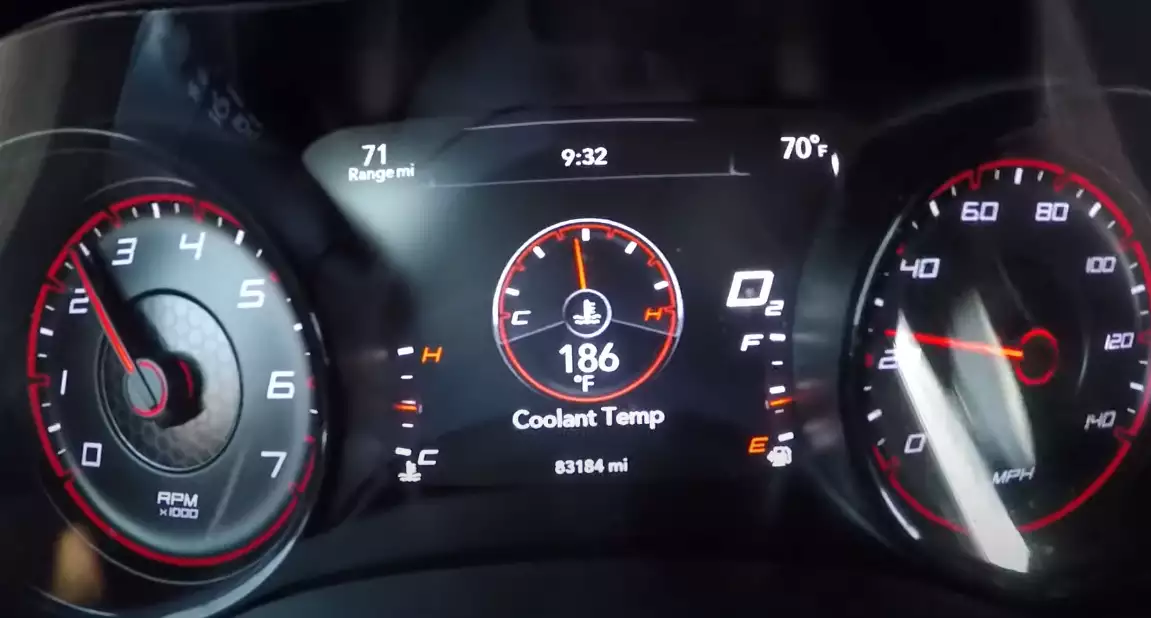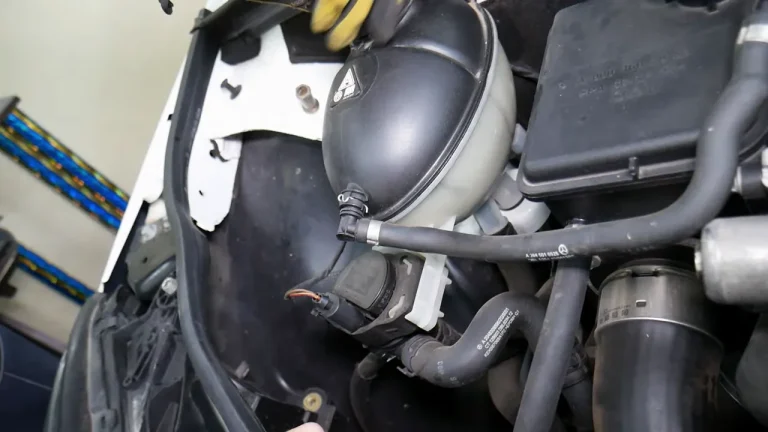What is Normal Engine Coolant Temperature? [Complete Guide 2024]
What is considered a typical operating temperature range for a vehicle’s engine? According to most experts, it is recommended for your engine to operate within the range of 195 degrees to 220 degrees Fahrenheit. Ideally, the needle on your temperature gauge should stay centered within this range under normal conditions.
The cooling system plays a crucial role in keeping the engine operating within a safe temperature range. Coolant, also known as antifreeze, absorbs heat from the engine and dissipates it through the radiator, preventing the engine from overheating. The average coolant temperature reflects the equilibrium between the heat produced by the engine and the cooling system’s ability to maintain an optimal range.
In this article, we will take a closer look at the importance of average coolant temperature and its impact on vehicle performance. We will discuss the various components of the cooling system, factors that influence coolant temperature, and the potential consequences of operating outside the recommended range. Furthermore, we will provide insights into how you can monitor and maintain the optimal average coolant temperature to ensure your vehicle operates smoothly and efficiently.
Whether you’re a car enthusiast or a daily commuter, understanding the significance of average coolant temperature will empower you to make informed decisions about your vehicle’s maintenance and overall well-being. So, let’s dive in and explore the world of coolant temperature and its critical role in vehicle performance.
What is Coolant Temperature?
Coolant temperature refers to the measurement of the heat level of the engine coolant circulating within a vehicle’s cooling system. The coolant, a mixture of water and antifreeze, plays a crucial role in maintaining the engine’s temperature within a safe and optimal range.
As the engine runs, it generates a significant amount of heat due to the combustion process. This heat must be regulated to prevent the engine from overheating, which can lead to severe damage and potential engine failure. The coolant absorbs heat from the engine, preventing it from reaching dangerous levels, and carries it away to be dissipated through the radiator.
The coolant temperature is typically monitored using a temperature sensor located in the engine block or radiator. This sensor sends signals to the vehicle’s engine control unit (ECU), which then displays the coolant temperature on the dashboard gauge or warning light. By monitoring the coolant temperature, drivers and mechanics can assess the engine’s thermal condition and take appropriate measures if it deviates from the recommended range.
Maintaining the proper coolant temperature is essential for engine performance and longevity. If the coolant temperature is too low, the engine may not reach its optimal operating temperature, leading to reduced fuel efficiency, increased emissions, and potential engine wear. On the other hand, if the coolant temperature is too high, it can cause overheating, leading to engine damage, reduced power output, and potential breakdowns.
Coolant temperature is a critical parameter that must be monitored to ensure proper engine functioning and prevent overheating. By maintaining the optimal coolant temperature, you can enhance vehicle performance, extend the life of your engine, and enjoy a smoother and more reliable driving experience.
The Cooling System
The cooling system in a vehicle is responsible for managing and regulating the engine’s temperature, ensuring it operates within a safe and optimal range. It consists of several components working together to dissipate excess heat and maintain the engine’s efficiency. Let’s take a closer look at the key elements of a typical automotive cooling system:
1. Radiator
The radiator is the primary component responsible for cooling the engine coolant. It is a heat exchanger consisting of a network of tubes and fins. As the hot coolant flows through the radiator, air passing over the fins helps dissipate the heat, lowering the temperature of the coolant before it returns to the engine.
2. Water Pump
The water pump is responsible for circulating the coolant throughout the cooling system. Driven by a belt connected to the engine, the water pump ensures a continuous flow of coolant between the engine, radiator, and other components.
3. Thermostat
The thermostat acts as a valve that regulates the flow of coolant based on the engine’s temperature. It remains closed when the engine is cold, allowing it to warm up quickly. Once the engine reaches the optimal operating temperature, the thermostat opens, enabling coolant flow to the radiator for cooling.
4. Coolant
Coolant, also known as antifreeze, is a mixture of water and chemicals designed to prevent freezing and boiling. It serves multiple purposes, including transferring heat from the engine to the radiator, lubricating the water pump, and providing corrosion protection for the cooling system.
5. Cooling Fans
Cooling fans help increase airflow through the radiator when additional cooling is needed. There are two types of cooling fans: electric fans, controlled by temperature sensors, and engine-driven fans, typically connected to the water pump.
6. Hoses and Belts
Hoses transport coolant between the engine, radiator, and other components. These hoses should be in good condition to prevent leaks. Belts, such as the one driving the water pump, ensure the proper functioning of the cooling system components.
7. Expansion Tank or Coolant Reservoir
The expansion tank or coolant reservoir provides a space for the coolant to expand and contract as it heats up and cools down. It helps maintain the coolant level in the system and allows for any excess coolant to be recirculated when needed.
Importance of Maintaining Optimal Coolant Temperature
Maintaining the optimal coolant temperature is of utmost importance for the overall performance, longevity, and reliability of your vehicle. Here are several reasons why it is crucial to ensure that your engine operates within the recommended temperature range:
Engine Performance
Operating within the optimal coolant temperature range ensures that your engine performs at its best. Engines are designed to work efficiently and deliver optimal power output within specific temperature parameters. When the engine is too cold, it may experience decreased fuel efficiency, increased emissions, and sluggish performance. Conversely, if the engine is too hot, it can lead to reduced power output, knocking, and potential engine damage.
Engine Longevity
Excessive heat can cause significant damage to engine components over time. When the engine runs too hot, lubricating oil may break down, leading to increased friction and wear on internal engine parts. Overheating can also cause damage to gaskets, seals, and other critical components. By maintaining the optimal coolant temperature, you help protect your engine from premature wear, minimizing the risk of costly repairs or even engine failure.
Fuel Efficiency
A properly regulated coolant temperature contributes to better fuel efficiency. When the engine operates within the recommended temperature range, the combustion process is optimized, resulting in more efficient fuel consumption. This means you can get the most out of each gallon of fuel and enjoy better mileage, saving you money at the pump.
Emission Control
Modern vehicles are equipped with complex emission control systems designed to minimize harmful pollutants. These systems rely on precise engine operating conditions, including coolant temperature, to function effectively. Operating outside the optimal temperature range can negatively impact emissions control, leading to increased pollution and potential compliance issues.
Consistent HVAC Performance
The cooling system not only regulates the engine temperature but also contributes to the proper functioning of your vehicle’s heating, ventilation, and air conditioning (HVAC) system. The HVAC system relies on the engine’s cooling system to maintain the desired cabin temperature. If the engine runs too hot or too cold, it can affect the HVAC performance, making it difficult to achieve comfortable interior temperatures.
Factors Influencing Average Coolant Temperature
Several factors can influence the average coolant temperature in a vehicle. Understanding these factors is essential for maintaining optimal engine temperature and ensuring the proper functioning of the cooling system. Here are some key factors that can impact the average coolant temperature:
Engine Load and Driving Conditions
The workload placed on the engine, such as towing heavy loads, driving uphill, or aggressive acceleration, can increase the heat generated by the engine. These demanding driving conditions may cause the coolant temperature to rise. It is important to monitor the coolant temperature gauge during such situations to prevent overheating.
Ambient Temperature and Climate
The outside temperature and climate play a significant role in determining the coolant temperature. In warmer climates, the cooling system has to work harder to dissipate heat, and the coolant temperature may be slightly higher. Conversely, in colder climates, it may take longer for the engine to reach its optimal operating temperature, potentially leading to lower coolant temperatures.
Cooling System Efficiency and Condition
The efficiency and condition of the cooling system components directly impact the average coolant temperature. If the radiator is clogged, the water pump is malfunctioning, or the cooling fans are not operating correctly, it can lead to inadequate heat dissipation and higher coolant temperatures. Regular maintenance and inspections of the cooling system are crucial to ensure its efficiency and address any potential issues promptly.
Coolant Type and Concentration
The type and concentration of coolant used in the cooling system can affect its ability to regulate temperature. It is important to use the recommended coolant type and maintain the proper coolant-to-water ratio as specified by the vehicle manufacturer. Incorrect coolant type or improper concentration can result in inadequate heat transfer and compromised cooling system performance.
Cooling System Modifications
Aftermarket modifications, such as installing a larger radiator or an additional cooling fan, can alter the coolant temperature. These modifications are often done to enhance the cooling system’s capacity and improve overall performance, especially in high-performance or modified vehicles.
Thermostat Operation
The thermostat plays a vital role in regulating coolant flow and controlling the engine temperature. A malfunctioning thermostat can cause the coolant temperature to deviate from the desired range. It is important to ensure the thermostat is functioning properly and opening and closing at the correct temperature thresholds.
Monitoring Coolant Temperature
Monitoring the coolant temperature in your vehicle is an essential aspect of vehicle maintenance and ensuring optimal engine performance. Here are a few methods commonly used to monitor coolant temperature:
Coolant Temperature Gauge
Most vehicles are equipped with a coolant temperature gauge on the dashboard. It provides a visual indication of the coolant temperature in real-time. The gauge typically has a range from cold to hot, with a midpoint indicating the optimal operating temperature. Regularly monitoring the gauge while driving allows you to keep an eye on the coolant temperature and detect any potential issues.
Warning Lights or Indicators
Some vehicles have warning lights or indicators that illuminate on the dashboard when the coolant temperature exceeds a certain threshold. These lights often appear as a thermometer symbol or a red temperature icon. If the warning light comes on or flashes, it indicates that the coolant temperature is too high, and immediate action is required to prevent engine damage. It is crucial to respond promptly to such warnings by safely pulling over and investigating the cause of the high coolant temperature.
On-Board Diagnostic (OBD) Systems
Many modern vehicles are equipped with OBD systems that can provide detailed information about various aspects of the vehicle, including coolant temperature. OBD systems allow you to access real-time data and diagnostic trouble codes related to the cooling system. Using an OBD scanner or a diagnostic tool, you can read the coolant temperature data and identify any anomalies or issues affecting the cooling system.
Aftermarket Coolant Temperature Gauges
In some cases, vehicle owners may choose to install aftermarket coolant temperature gauges for more precise monitoring. These gauges offer additional features and customization options, allowing you to monitor the coolant temperature more accurately and easily.
Effects of Abnormal Coolant Temperatures
Abnormal coolant temperatures, whether too high or too low, can have detrimental effects on your vehicle’s performance, reliability, and overall engine health. Let’s explore the consequences of operating with abnormal coolant temperatures:
1. Overheating (High Coolant Temperature):
– Engine Damage: Persistent overheating can lead to severe engine damage, such as warped cylinder heads, blown head gaskets, or even a cracked engine block. These issues can result in costly repairs or, in extreme cases, the need for engine replacement.
– Reduced Power and Performance: When the engine operates at excessively high temperatures, it may enter a “limp mode” to protect itself from further damage. This can cause a significant loss of power and reduced overall performance.
– Increased Emissions: Overheating can negatively impact emission control systems, leading to increased emissions of pollutants. This can result in compliance issues with emissions regulations.
2. Engine Wear (Low Coolant Temperature):
– Increased Friction: When the engine operates at lower temperatures than optimal, the oil may not reach its ideal viscosity. This can result in increased friction and wear on engine components, potentially leading to premature engine damage.
– Poor Fuel Efficiency: Engines that operate at lower temperatures may experience reduced fuel efficiency. The combustion process may not be as efficient, leading to increased fuel consumption and decreased mileage.
– Increased Deposits and Moisture: Coolant temperature that is consistently too low can contribute to the formation of deposits in the engine and the accumulation of moisture in the oil, both of which can impact engine performance and longevity.
3. Cooling System Issues:
– Component Failure: Extreme coolant temperatures can put excessive stress on the cooling system components, leading to their premature failure. This may include radiator leaks, water pump malfunctions, or damaged hoses.
– Coolant Leaks: Abnormal temperatures can cause expansion and contraction of cooling system components, potentially leading to coolant leaks. Leaks can result in a loss of coolant, further exacerbating overheating or low coolant temperature issues.
– Thermostat Malfunction: Coolant temperature abnormalities can also affect the proper functioning of the thermostat. A malfunctioning thermostat may fail to open or close at the appropriate temperatures, resulting in inefficient coolant flow and erratic temperature control.
Maintaining the Optimal Average Coolant Temperature
Maintaining the optimal average coolant temperature is crucial for the overall health and performance of your vehicle’s engine. Here are some important steps to help you achieve and maintain the recommended coolant temperature range:
1. Regularly Check Coolant Levels
Ensure that the coolant level is within the manufacturer’s specified range. Low coolant levels can lead to inefficient heat transfer and inadequate cooling, resulting in high coolant temperatures. If the coolant level is consistently low, it may indicate a leak in the cooling system that needs to be addressed promptly.
2. Use the Correct Coolant Type and Concentration
Use the coolant type recommended by the vehicle manufacturer. Different engines may require specific types of coolant, such as ethylene glycol or propylene glycol-based coolants. Additionally, maintain the proper coolant-to-water ratio as specified by the manufacturer. The correct concentration of coolant ensures proper heat transfer and efficient cooling.
3. Inspect and Maintain the Cooling System Components
Regularly inspect the condition of the cooling system components, such as the radiator, hoses, water pump, and thermostat. Look for signs of leaks, cracks, or damage. Replace any worn-out or damaged components to ensure optimal coolant flow and heat dissipation.
4. Keep the Radiator and Cooling Fins Clean
Over time, the radiator and cooling fins can accumulate dirt, debris, and bugs, restricting airflow and reducing cooling efficiency. Regularly clean the radiator and cooling fins using a soft brush or compressed air to remove any obstructions. This helps maintain proper heat dissipation and prevents overheating.
5. Monitor the Coolant Temperature Gauge
Pay attention to the coolant temperature gauge on the dashboard while driving. Familiarize yourself with the normal operating range indicated by the gauge. If the coolant temperature starts to rise above the normal range, it may indicate an issue with the cooling system that requires immediate attention.
6. Address Overheating Promptly
If you notice persistent high coolant temperatures or the temperature gauge approaching the red zone, take immediate action. Safely pull over, turn off the engine, and allow it to cool down. Avoid opening the radiator cap while the engine is hot, as it can lead to burns. Have your vehicle inspected by a qualified mechanic to diagnose and resolve the cause of overheating.
7. Follow Manufacturer’s Maintenance Schedule
Adhere to the recommended maintenance schedule provided by the vehicle manufacturer. This includes regular coolant flushes, which help remove any accumulated debris or contaminants in the cooling system, ensuring optimal performance.
FAQ:
Q: What is considered the average coolant temperature in a vehicle?
A: The average coolant temperature in a vehicle typically ranges between 190°F (88°C) and 220°F (104°C). However, the specific optimal temperature can vary depending on the vehicle make, model, and engine design. It’s important to consult your vehicle’s owner manual or contact the manufacturer for the recommended operating temperature range.
Q: Why is it important to maintain the average coolant temperature in a vehicle?
A: Maintaining the average coolant temperature is crucial for several reasons. Firstly, it ensures optimal engine performance by allowing the engine to operate efficiently within its designed temperature range. This helps achieve better fuel efficiency, power output, and overall performance. Secondly, it promotes engine longevity by reducing the risk of overheating, which can cause severe engine damage. Additionally, maintaining the average coolant temperature aids in controlling emissions, preventing excessive pollution, and ensuring compliance with environmental regulations.
Q: What can cause the coolant temperature to be higher than normal?
A: Several factors can contribute to a higher than normal coolant temperature. Common causes include a malfunctioning thermostat that fails to regulate coolant flow properly, a faulty radiator fan or fan clutch, a clogged radiator or cooling fins hindering heat dissipation, low coolant levels, coolant leaks, a failing water pump, or engine-related issues such as a blown head gasket or a restricted exhaust system. Regular maintenance and prompt diagnosis of any abnormalities are crucial to address high coolant temperatures.
Q: What are the potential consequences of operating with a coolant temperature that is too high?
A: Operating with a coolant temperature that is too high can lead to severe consequences. The engine may experience reduced power and performance, increased emissions, and potential damage to critical engine components. Overheating can cause warping of cylinder heads, blown head gaskets, or even engine block cracks. These issues often result in expensive repairs and, in extreme cases, the need for engine replacement.
Q: What are the potential consequences of operating with a coolant temperature that is too low?
A: Operating with a coolant temperature that is too low can also have adverse effects. It may result in increased friction and wear on engine components due to inadequate lubrication. Lower coolant temperatures can negatively impact fuel efficiency and may contribute to the formation of deposits in the engine. Additionally, operating with consistently low coolant temperatures can lead to poor heating performance in the vehicle’s interior during colder weather.
Q: How can I monitor the coolant temperature in my vehicle?
A: Most vehicles are equipped with a coolant temperature gauge on the dashboard. This gauge provides a visual indication of the coolant temperature in real-time. Additionally, some vehicles have warning lights or indicators that illuminate on the dashboard when the coolant temperature exceeds a certain threshold. You can also use on-board diagnostic (OBD) systems or aftermarket coolant temperature gauges for more detailed monitoring of the coolant temperature.
Q: What should I do if I notice abnormal coolant temperatures?
A: If you notice abnormal coolant temperatures, such as consistently high or low readings, it is important to take action. Safely pull over, turn off the engine, and allow it to cool down if it is overheating. Consult a qualified mechanic to diagnose and address the underlying issues causing the abnormal temperatures. Promptly addressing cooling system issues and maintaining the recommended coolant temperature range will help prevent further damage and ensure optimal vehicle performance.
- Why Are My Car Headlights Not Bright Enough? - May 9, 2024
- How Long Can You Drive With An EVAP Leak? - May 9, 2024
- What Does B Stand for in a Car? [Full Guide] - May 9, 2024


![Metric Vs Standard Wrenches [What’s The Difference?]](https://automhelp.com/wp-content/uploads/2023/06/Quick-reference-standard-wrench-sizes-in-order-SAE_000049455-768x432.webp)

